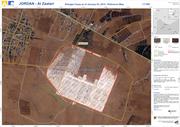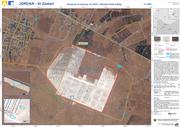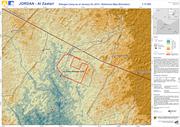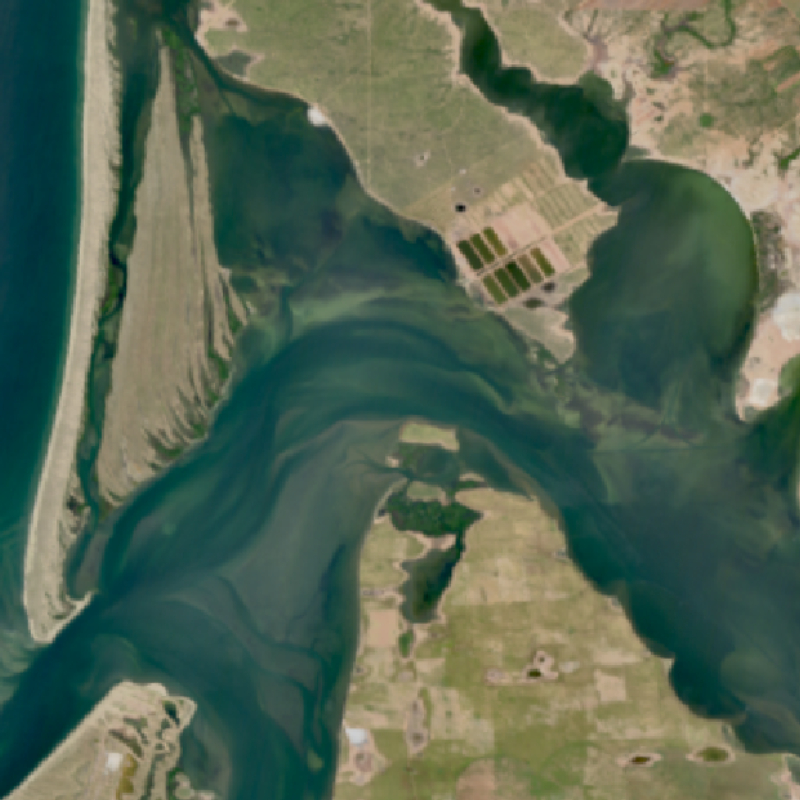Keyword
DLR
161 record(s)
Provided by
Type of resources
Available actions
Topics
Keywords
Contact for the resource
Update frequencies
Service types
-

The map shows the Al Zaatari refugee camp in Jordan. It is situated approx. 12 km from the Syrian border and in close proximity to the city of Al Mafraq (10 km). The camp was set up on July 28, 2012 to shelter refugees fleeing the conflict in Syria. The vector data have been digitized on the basis of WorldView-2 satellite data (0.5m spatial resolution) acquired on January 03, 2013. The results have not been validated in the field. WorldView-2 satellite data acquired on January 03, 2013 is used as backdrop. The products elaborated for this Rapid Mapping Activity are realised to the best of our ability, within a very short time frame, optimising the material available. All geographic information has limitations due to the scale, resolution, date and interpretation of the original source materials. No liability concerning the content or the use thereof is assumed by the producer. The ZKI crisis maps are constantly updated. Please make sure to visit http://www.zki.dlr.de for the latest version of this product.
-

The Al Zaatari refugee camp in Jordan is situated approx. 12 km from the Syrian border and in close proximity to the city of Al Mafraq (10 km). Due to heavy rainfall in the region parts of the Zaatari camp are affected by flooding. The map shows the flood situation derived by semi-automatic image analysis of TerraSAR-X data acquired on January 10, 2013 at 03:38:49 UTC. Furthermore basic reference information, digitized on the basis of WorldView-2 satellite data acquired on January 03, 2013, at 08:52:52 UTC, is depicted. The contour lines were derived from ASTER GDEM 2 data (vertical accuracy +/- 6m). For a more detailed view on the flood situation, parts of the camp area are also shown in the zoom boxes. The results of the image interpretation and analysis have not been validated in the field. WorldView-2 satellite data acquired on January 03, 2013, is used as backdrop. Please note that flood waters in settlement areas might not be fully captured and the water extent might be underestimated due to sensor characteristics. Thus especially shallow water bodies might not be fully captured. The products elaborated for this Rapid Mapping Activity are realised to the best of our ability, within a very short time frame, optimising the material available. All geographic information has limitations due to the scale, resolution, date and interpretation of the original source materials. No liability concerning the content or the use thereof is assumed by the producer. The ZKI crisis maps are constantly updated. Please make sure to visit http://www.zki.dlr.de for the latest version of this product.
-

The map shows the Al Zaatari refugee camp in Jordan. It is situated approx. 12 km from the Syrian border and in close proximity to the city of Al Mafraq (10 km). The camp was set up on July 28, 2012, to shelter refugees fleeing the conflict in Syria. The map shows general characteristics of the camp infrastructure, including camp extent, location of shelters, containers and facility buildings, road infrastructure and the runway area. For a more detailed view parts of the camp area are also shown in the zoom boxes. The vector data have been digitized on the basis of WorldView-2 satellite data (0.5 m spatial resolution) acquired on January 03, 2013. The results have not been validated in the field. WorldView-2 satellite data acquired on January 03, 2013, is used as backdrop. The products elaborated for this Rapid Mapping Activity are realised to the best of our ability, within a very short time frame, optimising the material available. All geographic information has limitations due to the scale, resolution, date and interpretation of the original source materials. No liability concerning the content or the use thereof is assumed by the producer. The ZKI crisis maps are constantly updated.
-

The map shows the elevation of the surroundings of the Al Zaatari refugee camp in Jordan. The elevation information is derived from ASTER GDEM 2 data (vertical accuracy +/- 6m). Furthermore basic reference information, digitized on the basis of WorldView-2 satellite data acquired on January 03, 2013, at 08:52:52 UTC and LANDSAT-7 data acquired on December 16, 2012 at 08:07:11 UTC, is depicted. Not all settlements are captured. The results have not been validated in the field. ASTER GDEM 2 data as well as a hillshade derived from this data is used as backdrop. Please note, that information on elevation derived from ASTER data does not apply for the refugee camp area. ASTER data was acquired before 2011 and the elevation might have changed due to construction works. The products elaborated for this Rapid Mapping Activity are realised to the best of our ability, within a very short time frame, optimising the material available. All geographic information has limitations due to the scale, resolution, date and interpretation of the original source materials. No liability concerning the content or the use thereof is assumed by the producer. The ZKI crisis maps are constantly updated. Please make sure to visit http://www.zki.dlr.de for the latest version of this product.
-

The EnMAP HSI L2A dataset collection comprises a standardized, consistent, systematically processed, and cloud-native level-2A dataset series for the entire mission. It is especially useful for big data or time series analyses. The dataset is processed with the atmospheric correction over land processor and is provided in cloud-optimized GeoTIFF format for direct access and download. The metadata follows the CEOS Analysis Ready Data (CEOS-ARD) framework. The database is constantly updated with newly acquired data. The Environmental Mapping and Analysis Program (EnMAP) is a German hyperspectral satellite mission that monitors and characterizes Earth’s environment on a global scale. EnMAP delivers accurate data that provides information on the status and evolution of terrestrial and aquatic ecosystems, supporting environmental monitoring, management, and decision-making. For more information, please see the mission website: https://www.enmap.org/mission/
-

This collection contains Sentinel-2 Level 2A surface reflectances, which are computed for the country of Germany using the time-series based MAJA processor. During the Level 2A processing, the data are corrected for atmospheric effects and clouds and their shadows are detected. The MAJA L2A product is available online for the last 12 months. Further data are kept in the archive and are available upon request. Please see https://logiciels.cnes.fr/en/content/maja for additional information on the MAJA product. The MAJA product offers an alternative to the official ESA L2A product and has been processed with consideration of the characteristics of the Sentinel-2 mission (fast collection of time series, constant sensor perspective, and global coverage). Assumptions about the temporal constancy of the ground cover are taken into account for a robust detection of clouds and a more flexible determination of aerosol properties. As a result, an improved determination of the reflectance of sunlight at the earth's surface (pixel values of the multispectral image) is derived. Further Sentinel-2 Level 2A data computed using MAJA are available on the following website: https://theia.cnes.fr
-
This WMS provides access to different elevation products provided by the Earth Observation Center (EOC) of the DLR.
-

UV Index (UVI) as derived from TROPOMI observations. The UVI describes the intensity of the solar ultraviolet radiation. Values around zero indicate low, values greater than 10 indicate very high UV exposure on the ground. The TROPOMI instrument onboard the Copernicus SENTINEL-5 Precursor satellite is a nadir-viewing, imaging spectrometer that provides global measurements of atmospheric properties and constituents on a daily basis. It is contributing to monitoring air quality and climate, providing critical information to services and decision makers. The instrument uses passive remote sensing techniques by measuring the top of atmosphere solar radiation reflected by and radiated from the earth and its atmosphere. The four spectrometers of TROPOMI cover the ultraviolet (UV), visible (VIS), Near Infra-Red (NIR) and Short Wavelength Infra-Red (SWIR) domains of the electromagnetic spectrum. The operational trace gas products generated at DLR on behave ESA are: Ozone (O3), Nitrogen Dioxide (NO2), Sulfur Dioxide (SO2), Formaldehyde (HCHO), Carbon Monoxide (CO) and Methane (CH4), together with clouds and aerosol properties. This product is created in the scope of the project INPULS. It develops (a) innovative retrieval algorithms and processors for the generation of value-added products from the atmospheric Copernicus missions Sentinel-5 Precursor, Sentinel-4, and Sentinel-5, (b) cloud-based (re)processing systems, (c) improved data discovery and access technologies as well as server-side analytics for the users, and (d) data visualization services.
-

Grassland mowing dynamics (i.e. the timing and frequency of mowing events) have a strong impact on grassland functions and yields. As grasslands in Germany are managed on small-scale units and grass grows back quickly, satellite information with high spatial and temporal resolution is necessary to capture grassland mowing dynamics. Based on Sentinel-2 data time series, mowing events are detected throughout Germany and annual maps of the grassland mowing frequency generated. The grassland mowing detection approach operates per pixel, including preprocessing of the Enhanced Vegetation Index (EVI) time series and a calibrated rule-based grassland mowing detection which is specified in more detail in Reinermann et al. 2022, 2023.
-

Hedgerows play an important role in maintaining biodiversity, carbon sequestration, soil stability and the ecological integrity of agricultural landscapes. In this dataset, hedgerows are mapped for the whole of Bavaria. Orthophotos with a spatial resolution of 20 cm, taken in the period from 2019 to 2021, were used in a deep learning approach. Hedgerow polygons of the Bavarian in-situ biotope mapping from 5 districts (Miltenberg, Hassberge, Dillingen a.d. Donau, Freyung-Grafenau, Weilheim-Schongau) as well as other manually digitized polygons were used for training and testing as input into a DeepLabV3 Convolutional Neural Network (CNN). The CNN has a Resnet50 backbone and was optimized with the Dice loss as a cost function. The generated hedgerow probability tiles were post-processed by merging and averaging the overlapping tile boundaries, shape simplification and filtering. For more details, see Huber Garcia et al. (2025). The dataset has been created within the project FPCUP (https://www.copernicus-user-uptake.eu/) in close cooperation with Bayerisches Landesamt für Umwelt (LfU).
 www.geodatenkatalog.de (S3L)
www.geodatenkatalog.de (S3L)